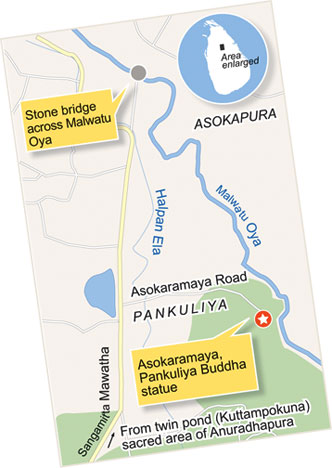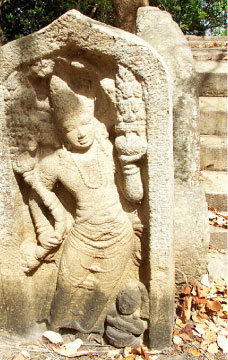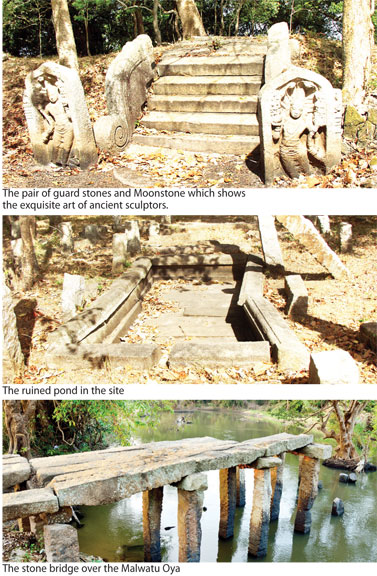The forgotten past of Pankuliya
Story and pictures by Mahil Wijesinghe

|

Buddha head of Pankuliya |
Scrambling over the ruins that seem to cover every inch as far as the
eye could see, we made our way through in search of the impressive
archaeological site of Pankuliya where a magnificent Buddha statue is
located hidden amidst the ruins and lush green serene setting surrounded
by vast stretch of paddy fields encompassing the Malwatu Oya which flows
through the area.
Though it is called Asokaramaya today, this was known as Pankuliya in
ancient time. In fact, Pankuliya or Asokaramaya is one of the unique
places where the grandeur of finest creation of ancient Sinhala arts is
showcased vividly.
The word 'Pankuliya' evokes much excitement may be because we hear
less about this little village on the outskirts of Anuradhapura with its
farming community. This is literally a road rarely travelled by the
usual pilgrim or tourist.
On the way to Pankuliya we passed about five kilometers from the road
leading to Gal Paalama (stone bridge) from Kuttampokuna in Anuradhapura,
where we came across a residential area and a notice board showing a
road on the right side to the Asokaramaya or Pankuliya.
At this junction about a one kilometer, narrow motorable road ends
abruptly in the middle of the paddy fields. From this point no vehicle
can enter and we walked about 500 metres along the deserted footpath to
the Pankuliya archaeological site amidst the breeze from Malwatu Oya. On
either side, vast green paddy fields spread across the flat landscape
and the calls and dances of the peacocks added to the serenityin the
morning.
|

The Buddha statue of Pankuliya which displays Abaya Mudra,
is a marvellous creation of ancient sculptors. |
 The main road about one and half kilometres across the vast stretch
of paddy fields, leads to an ancient stone bridge over Malwatu Oya,
close to Pankuliya. This ancient bridge made of stone once is a marvel
of engineering of the days gone by. Many of the pillars of stone which
held up the structure still stand, some near the bank, some further
away, with a few sticking up mid-stream and some of which are still
visible. The main road about one and half kilometres across the vast stretch
of paddy fields, leads to an ancient stone bridge over Malwatu Oya,
close to Pankuliya. This ancient bridge made of stone once is a marvel
of engineering of the days gone by. Many of the pillars of stone which
held up the structure still stand, some near the bank, some further
away, with a few sticking up mid-stream and some of which are still
visible.
Asokaramaya is located in one acre of land in a serene setting amidst
a lush green canopy surrounding the the village of Pankuliya. This is a
fairly unknown site to the average pilgrim but houses one of the finest
stone carved Buddha statues in the country today. This statute almost
equals the artistic qualities of the famous Samadhi Buddha statue at the
Mahamevna Uyana and the Tholuvila Buddha statue which is now kept in the
Colombo museum. This statue is also known as Pankuliya Buddha.
Unfortunately this area has been neglected and isolated, rarely visited
by the pilgrims although it has been conserved by the Department of
Archaeology.
Although we don't have any historical information of the site,
Pankuliya is believed to have been built by Princess Asokamala, the
consort of Prince Saliya, but there is no actual evidence to prove it
further. However, archaeologists believe that the complex was most
likely a nunnery according to the inscription of King Dappula V
(918-930) BC, found at the site. Presently this archaeological site is
popular among the historians and archaeologists because of its Buddha
statue.
|

The old photograph of Pankuliya Buddha which appeared in the
Buddhist Annual of Ceylon in 1927 |
 The multitude of ruin structures scattered throughout the complex are
remnants of the ruined Dagaba which lies beside the image house. They
have been conserved and constructed on a platform at a higher elevation
from the ground. There are four cardinal entrances to ascend the Dagaba
with a flight of steps and at the bottom of the each flight of steps
contain a unique stone carved pair of guard stones which showed much
antiquity of the complex and what we can see today is only its brick
foundation. The multitude of ruin structures scattered throughout the complex are
remnants of the ruined Dagaba which lies beside the image house. They
have been conserved and constructed on a platform at a higher elevation
from the ground. There are four cardinal entrances to ascend the Dagaba
with a flight of steps and at the bottom of the each flight of steps
contain a unique stone carved pair of guard stones which showed much
antiquity of the complex and what we can see today is only its brick
foundation.
However, venturing in, soon we were surrounded by countless ruins
which included stone pillars, flower altars, a ruined stone bathing
pond, Janthaghara, guard stones, remnants of two stone stands to keep
Punkalas and several stone pots which were kept beside each flight of
steps to ascend the platforms. The archaeologists believe that these
pots would have been kept full of water to wash hands and feet of
pilgrims before they ascended the elevated sacred areas.
Several uneven stone pillars and beautiful stone carved moonstone
with a pair of stone carved guard stones which are an exquisite work of
art by ancient sculptors lead to the image house on the higher platform.
Taking in the serene atmosphere that held a spell of enchantment, we
made our way to the unique image house where the Buddha statue of
Pankuliya has been placed on a concrete structure. The several ruined
pillars which are located near the image house probably indicate that
there had been a roof over the statue in the past.
|

The brick foundation of ruined Dagaba which was conserved by
the Dept. of Archaeology in the recent past. |
However, the Buddha statue of Pankuliya according to the
archaeologists may belong to the ninth or tenth century in late
Anuradhapura period. It is also a unique masterpiece of Sinhala Buddhist
sculpture. The statue is sculptured out of dolomite marble, seated in
Virasana posture and displays the Abaya Mudraa. The hollowed carved eyes
indicate that they were once studded with precious stones - treasure
hunters have removed those long ago.
 The six feet and nine inches tall dolomite carved Buddha statue of
Pankuliya has been exposed to natural elements such as rain, breeze and
sun for centuries. A modern roof has been erected over the statue by the
Dept. of Archaeology in the recent past, although this somewhat affects
the real beauty of the statue. But its enchanting aesthetic appeal and
sense of serenity has never been lost even though it has been exposed to
the mercy of the elements. The six feet and nine inches tall dolomite carved Buddha statue of
Pankuliya has been exposed to natural elements such as rain, breeze and
sun for centuries. A modern roof has been erected over the statue by the
Dept. of Archaeology in the recent past, although this somewhat affects
the real beauty of the statue. But its enchanting aesthetic appeal and
sense of serenity has never been lost even though it has been exposed to
the mercy of the elements.
Paying our homage at the Buddha statue of Pankuliya at the image
house, we went outside stopping for a moment to look at the surrounding
vista. Through the ruins and paddy fields we glimpsed the sacred
Ruwanweli Maha Seya in the distance.
With the sun setting low, we had to end our journey. I had visited
the Buddha statue of Pankuliya 15 years ago, what drew me back was the
profound serenity of this desolated spiritual site.
|

The Ruwanweli Maha Seya seen through the Pankuliya
archaeological site. |
|

